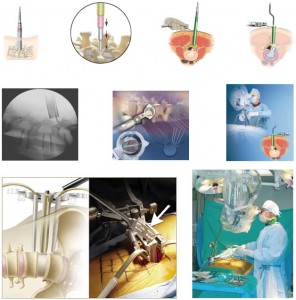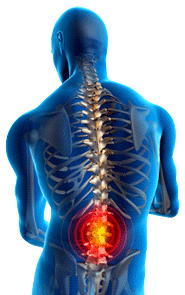
choice should be the latest minimally invasive technique developed by our world class hospitals in India. Most advanced Technology like Intra Operative MRI, Brain Suite and Computer Assisted Navigation System are deployed by highly trained surgeons for accurate and safe Spine Surgeries through a small incision. Minimally invasive spine surgery (MISS) uses advanced technology and innovative techniques to treat back pain and neck pain caused by a variety of spinal disorders.
Some of the spinal conditions MISS can treat are:
- degenerative disc disease
- herniated discs
- scoliosis
- spinal stenosis
Minimally Invasive Spine Procedures
Microsurgical Discectomy – Microsurgical Discectomy is a procedure performed by utilizing a tubular device inserted through a very
small incision. Muscles are moved aside to see the vertebrae. The herniated portion of the disc is removed to allow room for the nerve to resume its normal position. There is less damage to nearby parts of the spine. Patients tend to recover faster
Endoscopic Discectomy – Many surgical procedures have been revolutionized by the use of special TV cameras. The procedure is still
the same, but even smaller incisions (1/4 inch) are made to insert a special magnified TV camera into the spinal canal so that the surgeon can actually see the disc material. Through these tiny incisions, the camera and several other surgical instruments are inserted.
Transforaminal Interbody Lumbar Fusion – Transforaminal Lumbar Fusion (TLIF) is a surgical technique that is performed from a posterior approach to stabilize the spinal vertebrae and disc between. By going through the transforaminal direction there is less bone removed so thus less disturbance to the site. By fusing the vertebrae to eliminate any movement between the bones, the spine is stabilized and a reduction of pain and nerve irritation is accomplished
Posterior Lumbar Interbody Fusion (PLIF) – Posterior Lumbar Interbody Fusion (PLIF) is a surgical technique for placing bone graft between adjacent vertebrae (interbody). Using various instruments, the disc is removed through the right and left sides of the spinal canal and the intervertebral space, which has been cleared, is then packed with bone graft and a bone block or cage implant. Instrumentation, such as pedicle screws, are used to provide support for the fused vertebrae. Additional bone graft may be placed to ensure a solid fusion.
Nucleoplasty or Percutaneous Discectomy – Nucleoplasty or Percutaneous Discectomy is a procedure utilized for the treatment of
chronic back pain caused by a contained herniated disc. This minimally invasive procedure uses a needle that is placed into the center of the disc where a series of channels are created to remove tissue from the nucleus.
Unmatched Benefits of Minimally Invasive Spine Surgery
1. Much lesser risk of post surgery complications, infection
2. Shorter, more comfortable post-operative recovery
3. Better clinical outcomes i.e an enhanced opportunity to regain physical function.
To know more about Minimally Invasive Spine Surgery in India please visit this link : https://safemedtrip.com/minimally-invasive-spine-surgery-in-india.html

 Click to WhatsApp
Click to WhatsApp +91-9899993637
+91-9899993637




